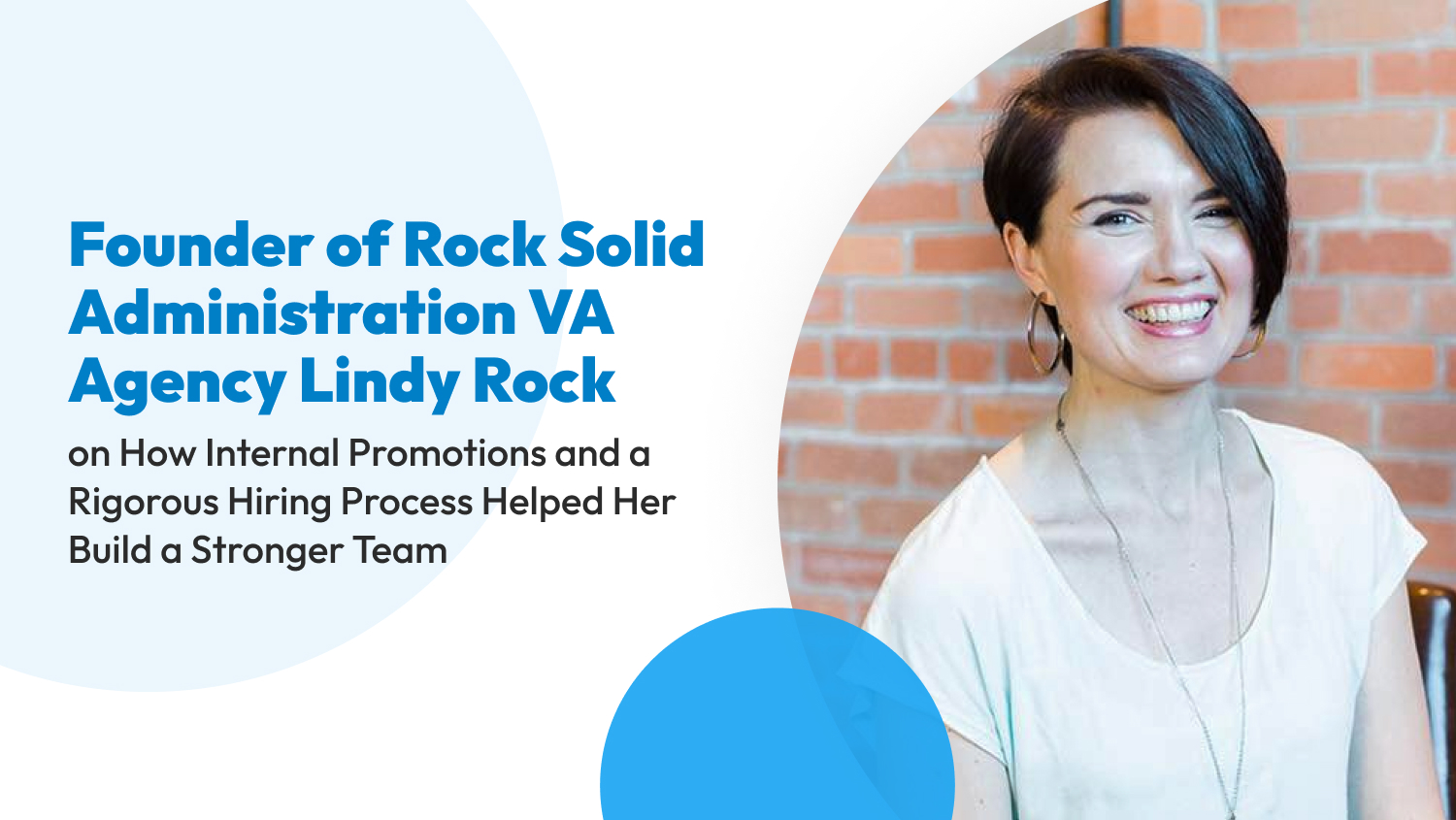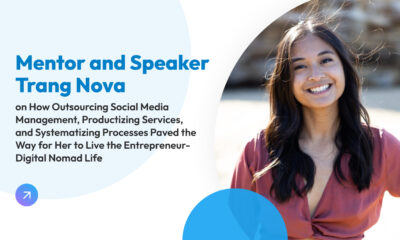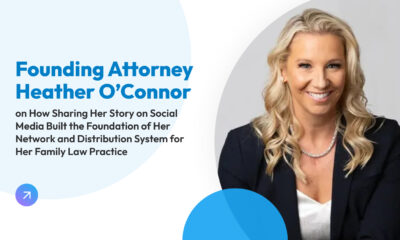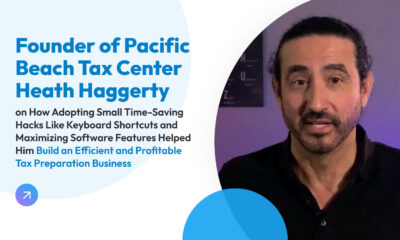Case Study
Founder of Rock Solid Administration VA Agency Lindy Rock on How Internal Promotions and a Rigorous Hiring Process Helped Her Build a Stronger Team
When Lindy Rock was laid off in 2014, the Canadian economy was in slowdown, and she was preparing for a life of solo parenthood with two young sons. Believing that having her own business would give her more time to be with her kids, she decided to turn her part-time virtual assistant services into a full-time business. Nine years later, Rock now runs a successful VA agency, Rock Solid Administration, that serves established online businesses with administrative support and automation.
In this article, we learn about Rock’s evolution from part-time virtual assistant to agency owner and the people, systems, and tools that have helped her overcome the challenges along the way. Don’t forget to check out her Productivity Stack Quick Reference and Read List at the end.
Table of Contents
- Starting
- Growing
- Scaling and Success
- Hindsight: What Rock would have done earlier
- Wrap Up
- Rock’s Productivity Stack Quick Reference
- Rock’s Reading List
- More about Lindy Rock
Starting
Challenge 1: Distribution: Finding more clients for her full-time VA business
Back in 2014, Rock had been doing part-time virtual assistant-type work for a friend who was a business coach and mortgage broker. “I was working from home, helping her with client support and managing emails and her onboarding and off-boarding of her mortgaging clients and that kind of stuff.” Once she had decided to do this full-time, she needed to find a way to tell more people about her VA services.
Solution: Rock attended networking events and made connections online. “I started talking to more businesses, going to BNIs, joining Facebook groups, that kind of thing, so that I could talk to people and tell them what I did.”
Her friend, the business coach/mortgage broker, also recommended her services. She recalls, “My first couple of clients were actually because of the friend that I had already been [working] with. She had recommended me to a few of her clients. They hired me, and then those people started talking to other people and so on and so forth.”
People: Rock, her business coach friend
Systems: Turning a side hustle into the main income source, virtual and face-to-face networking, word-of-mouth/referral system
Growing
Challenge 2: Delegation: Hiring to manage the workload
Rock worked solo for about a year. She offered a variety of VA services, from social media, newsletters, invoicing, and email and schedule management as she tried to figure out her niche. But her client list had grown so long it was too much for her to handle by herself. She was working 12-16 hour days and knew she needed help.
“It’s kind of ironic because I came on to help small businesses with their overwhelm and then became overwhelmed myself.”
And although she was able to work from home, that time freedom to be with her kids, which she had expected going into business (instead of finding another job), certainly wasn’t turning into a reality.
Solution: Rock hired a contractor to split the workload with her. She would review the work of her new hire but would still be the one to connect with the client, acting like a project manager. This arrangement didn’t last very long, though, first because Rock didn’t enjoy that type of project management, and second, she believed this arrangement didn’t serve the clients well.
“I’ve built my agency on the relationship side of it. I really believe that to get true quality work out of your VA, they need to know your business. So now, my VAs work directly with their clients. I oversee the client management, make sure that they’re happy, give them ideas of other things that they can pass off to us, and have meetings with them, that kind of thing.”
After that first hire, it became clear to her how she wanted to run her agency and how important the direct relationship between a VA and the client is. With this agency model in mind, she continued to grow her team as more clients came asking for her services. She hadn’t yet figured out the time management side of things, but she became more comfortable with delegation and building a team.
People: Rock, her first contractor VA
Systems: Finding an assignment of roles that worked both for her team and in the best interest of clients
Challenge 3: Having the right team to support client needs
As her client list and her team grew, Rock didn’t hire according to specialist roles. Her team, especially in the early years, offered more of a ‘jack-of-all-trades’ style of VA services. How did she ensure her VAs could deliver on different client requirements, which can span different skills?
Solution: She tried to match VAs with clients who needed their particular skills and interests. Also, her team members support each other, even if it means pitching in on something outside of your client assignment.
“I always tell people that we kind of have a hive mind. We have so many people on the team that have such amazing skill sets that [if a VA] can’t do something for [the client] because they don’t have that skill set, we have somebody else on the team who could hop in and help or at the very least to give advice on how that could be done.”
Over time, her agency narrowed down its services to administrative support, OBM, and tech or systems support and automation. This has helped better align the skills of VAs she brings on board with the types of services that clients expect.
People: Rock, her team
Systems: Matching VAs skills with client needs, teamwork, and flexible assignments across her VA team, niching down to better align VA skills with client needs
Challenge 4: Choosing her own tools and systems
With a business dealing with high volumes of administrative tasks for many clients, it was a struggle not to have the agency’s own systems and tools in place. In the earlier years, Rock was able to extensively study her clients’ tools, doing a deep dive into them to help clients better. But for her own business, she could only try out the free versions.
“At the time, you’re just starting out, and you’re like, ‘Well, I’m paying somebody else, and then I’m trying to make money, and I’ve got a mortgage and kids and whatever. So I was trying to use as many free tools as possible to get what I needed.”
Solution: By the third year of business, as her team and financial capacity grew, she focused on finding the right tools for her business and making them work for her. Having experience with different tools her clients used, she was able to compare and decide which ones she liked better.
For task and team management, she went with ClickUp. This is where her team stores SOPs, and where workflows like tasks and new client assignments are created and tracked.
For client onboarding, invoices, quotes, and contracts, she chose Dubsado, which she likes for its workflows. “It’s easy to set up and let it run so that you’re not constantly hopping in and out of something trying to send an email to somebody and forgetting, which is my issue.”
They use LastPass for password management, Google Calendar for scheduling, Infusionsoft for email marketing, Xero for bookkeeping, Planable for social media scheduling, and Read.ai for transcriptions.
Rock is also a big fan of Loom. “We use Loom for all of our SOPs. From there, we just grab the transcript, and we upload the video and transcript to ClickUp so that everybody can go and find what they need to find.”
People: Rock, her team of VAs
Systems: Making the most use of free tools, choosing tools suited to her processes and preferences
Tools: ClickUp, Dubsado, LastPass, Google Calendar, Xero, Loom, Infusionsoft (now Keap Max Classic), Planable, Read.ai
Scaling & Success
Challenge 5: Delegation: How to decide what tasks or roles to outsource
Rock decided to keep working directly with one or two clients as her team grew. But an expanding team and business meant she needed to dedicate time to managing her team and the administrative and marketing tasks in her company. Were these things she could outsource, and what were her criteria for deciding what she could delegate?
Solution: Rock first delegations in terms of leadership roles in her team focused on: 1) who can do it better and 2) what creates a more streamlined workflow.
The role of VA manager, responsible for the day-to-day support of the team and answering questions on the job, was not something she particularly disliked. But she needed to block off time to work with her own clients, and she realized she had someone on the team who was already doing it on an ad hoc basis. Rock thought this VA, who had been with the team for about three years by then, would be a great fit for the job. It turned out this person loved the idea of stepping into that role, and she has been the VA manager of the agency for the last three years.
The second role she delegated was the administrative part of client management and OBM. Again, she didn’t dislike these functions, but she looked at who could do this better and what made sense in terms of their current workflows. She asked another member of her VA pool who had taken an OBM course, was a master at ClickUp, and at that point, was handling a lot of the task management set-up. This team member happily accepted the new role and is now the OBM who manages client onboarding and client care, SOPs, and keeping Rock on track with her goals.
Her most recent delegation was more based on the ‘crap you hate’ criteria. Social media management for the business is something that drains her energy. So about one and a half years ago, she tapped another VA team member for the role. This social media manager requests Rock to provide raw content like videos or images, and she takes care of editing, captioning, scheduling, and posting these.
Rock takes a comprehensive view and approach to delegation. “There are some things that I actually liked doing that I still outsourced because it doesn’t make the most sense for me to do it. It’s not that I can’t or that I wouldn’t. It’s that it wasn’t the best use of mine or [my team’s] time.”
With these internal delegations, Rock is also able to demonstrate her support for the team in terms of learning and career growth. It helps with the transition of roles and retention of team members. She tells us, “I love promoting from within. And I also love people learning new things. If they’re interested, I’m more than happy to give them more of [a different] type of work or move them into a different position or whatever they need.”
People: Rock, OBM, VA manager, social media manager
Systems: Delegating tasks based on what makes sense in terms of workflow, who can do it better, and what you don’t like, internal promotions
Tools: ClickUp, Dubsado, Loom, Instagram, LinkedIn, Facebook
Challenge 6: Delegation: Refining hiring processes to weed out candidates who are not a good fit for the company
Building her team wasn’t always smooth sailing, though. As she hired contractor VAs over the years, Rock started having trouble with people being unreliable or not delivering work to her standards. “I have an ideal of [how the] client should be supported, and not everybody has the same ideals as me. And it’s hard to find that out in an interview when you’re not working directly with them.”
Even asking candidates to do a small project during the screening phase was not enough to reliably determine who would be a good fit for her team. Sometimes new hires quit because they realize working from home wasn’t for them!
Solution: Rock changed the entire screening process. From previously interviewing candidates by herself, checking a few references then asking them to do a small project, she now has a two-step questionnaire and involves her OBM and VA manager in the screening and interviews.
Rock, her OBM and VA manager, make the first shortlist by reviewing responses to the first questionnaire. They send this shortlist a second questionnaire which requires a two-minute video introduction to get a better feel for the candidate. Then Rock and her leadership team sit down and meet with their final shortlist at least once, at which point they assign the small project.
Rock says, “So it’s a bit of a more extensive process for us to hire now, but we’ve found much better people to come on board.”
People: Rock, OBM, VA manager
Systems: Putting in place an extensive hiring process that involves her leadership team to test the seriousness and commitment of applicants
Tools: Facebook VA groups, Indeed
Challenge 7: Time management: Managing CEO time, billable hours, and time with family
One of the main reasons Rock went into business was to have time for her then-young family. She wanted to volunteer at her kids’ school, go on field trips with them and be home when they were sick. She assumed she would have this kind of time flexibility even as she started a business practically from the ground up. She now knows, “Owning a business is hard in the first couple of years.”
During the first two years of her business, she didn’t have any time management strategies in place. Rock would respond to urgent requests and questions at the drop of a hat, switch tasks continuously throughout the day, and try to manage her small team and her own client work simultaneously.
How did she transition to more sustainable time management strategies that would allow her CEO time, direct client work, and family time?
Solution: Beginning in the third year of business, when she had started to be more deliberate about setting up systems, tools and building a team, she started with time-blocking. She would start with checking emails in the morning, uninterrupted hours for client work, responding to emails after lunch, and marketing the business on Facebook groups in the afternoon. She makes sure to schedule 15-min breaks throughout these client time blocks to make sure she gets up from the desk!
She also transitioned to a more structured work schedule where Mondays are for planning the workweek, producing social media content as requested by her social media manager, and other tasks related to working on the business. Tuesdays to Thursdays are for client work and meeting with her leadership team, while Fridays are reserved for spending time with her sons.
It has taken some years, but she is now catching up on family time. During the early days of her business, she could only commit to 30 minutes of bedtime stories every night, walks to school, and drove to their sports events. Today, she has a whole day in the week just for her sons.
People: Rock, OBM manager, VA manager, social media manager
Systems: Theme days, time blocking, delegating some tasks
Tools: Google Calendar, Email, Facebook, ClickUp, Dubsado, LastPass, Xero, Loom, Infusionsoft (now Keap Max Classic), Planable, Read.ai
Hindsight: What Rock would have done earlier
Rock was quick to point out what she would have done sooner: Hire team members, skip the project manager setup and go straight to having VAs work directly with clients, and set up systems and tools to save time and stress.
But she puts the biggest emphasis on hiring early and even repeats the same message to her clients. “I’ve told clients and potential clients for years, ‘You’ve got to hire before you think you need them.’ I hired late, and then I was scrambling to try and figure out how to get this person everything they need and feeling even more overwhelmed because I’m trying to teach them, while I’m super busy.”
Wrap Up
Rock built her agency on a foundation of strong client relationships, but it was the gradual addition and refinement of systems within her business that has enabled her and her VAs to be the rock-solid team they are today. The adoption of tools, delegation of leadership roles, developing an effective screening strategy, and time management for effective CEO time have been crucial elements to get her agency humming along productively.
Building her team taught Rock about her own leadership style, what she liked and didn’t like to do, as well as how to think about delegation from a more holistic standpoint. Delegation is not just about asking someone else to do what you don’t like or don’t have time for. It has to make sense from the business standpoint in terms of streamlined workflows, assigning someone better at that task than you, and ultimately freeing the business owner to do what would be the best use of her time.
Her struggle with ‘bad hires’ helped her improve her screening and vetting process. Spending more time on a multi-step assessment process, testing skills, work ethic, fit with the team, and getting input from her leadership team helped her find better candidates who stayed longer. Prioritizing growth and internal promotions certainly help with retention as well.
Rock’s message to entrepreneurs based on her experience building her business and her expertise in providing administrative support is to hire before you need to. This makes the delegation and transition easier and gives you that leg up in growing and scaling your business.
Rock’s Productivity Stack Quick Reference
Starting
Growing
- Loom
- Infusionsoft (now Keap Max Classic)
- Planable
- Read.ai
Scaling & Success
- Google Calendar
- ClickUp
- Dubsado
- LastPass
- Xero
- Loom
- Infusionsoft (now Keap Max Classic)
- Planable
- Read.ai
Rock’s Reading List
- Who Not How: The Formula to Achieve Bigger Goals Through Accelerating Teamwork by Dan Sullivan and Dr. Benjamin Hardy – This changed her mindset on delegation and got her questioning just because she can do everything, should she? This got her started in thinking about what tasks are good for her to keep and which ones are best taken off her plate.
- Do Nothing: How to Break Away from Overworking, Overdoing, and Underliving by Celeste Headlee. This one got her thinking about why we think the hustle culture and 40-hour workweeks are the gold standard.
More about Lindy Rock
Lindy has used her 20 years of administrative experience to create Rock Solid Administration. She works with small businesses, entrepreneurs, and big corporations to streamline their administrative staff. Lindy wants clients doing the work that best suits their strengths and hiring Virtual Assistants to do the work that doesn’t.
Her priority is to help clients set and achieve their business goals. Lindy will always hold clients accountable to the standards they set. She is happiest when she can help achieve targets and make a business more successful by taking some of the weight off her clients’ shoulders.
If you would like to learn more about Lindy and her team, you can reach them on:
Website: https://www.rocksolidadministration.com/
Facebook: https://www.facebook.com/rocksolidadmin
Instagram: https://www.instagram.com/rocksolidadmin/
LinkedIn: https://www.linkedin.com/company/rock-solid-administration/












